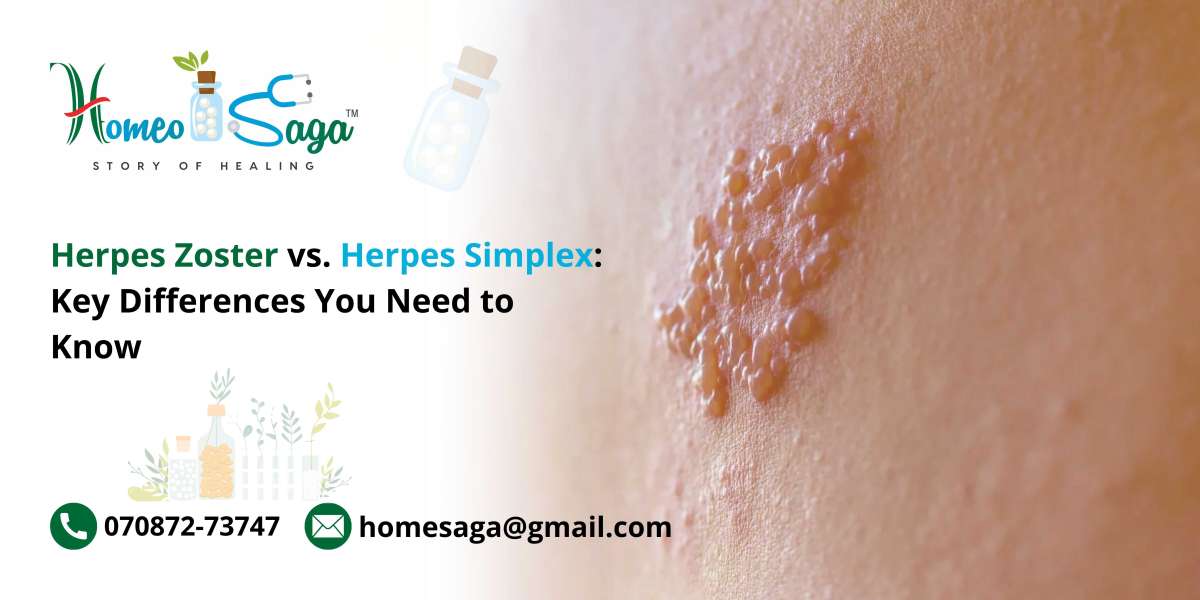When discussing viral infections, two names that often come up are Herpes Zoster and Herpes Simplex. While they may sound similar, these viruses are distinct in many ways. Understanding the differences between Herpes Zoster and Herpes Simplex is crucial for effective prevention, treatment, and management of symptoms. In this blog, we’ll explore the key differences between these two herpes viruses, their symptoms, causes, treatment options, and how they can impact your health.
What are Herpes Zoster and Herpes Simplex?
Herpes Zoster, commonly known as shingles, is caused by the reactivation of the varicella-zoster virus (VZV), which also causes chickenpox. After a person recovers from chickenpox, the virus remains dormant in the body and can reactivate later in life, often leading to Herpes Zoster.
Herpes Simplex, on the other hand, refers primarily to two types of viruses: Herpes Simplex Virus type 1 (HSV-1) and Herpes Simplex Virus type 2 (HSV-2). HSV-1 typically causes oral herpes, characterized by cold sores, while HSV-2 is most often associated with genital herpes. Both types can be transmitted through direct contact with an infected individual.
Symptoms
One of the most significant differences between Herpes Zoster and Herpes Simplex lies in their symptoms.
Herpes Zoster typically presents with:
- Pain, burning, or tingling in a localized area
- A rash that develops into fluid-filled blisters
- Fever and fatigue
- Sensitivity to light
The rash generally follows a dermatomal pattern, meaning it affects specific areas of the skin corresponding to a single nerve root. The blisters can be quite painful and may take several weeks to heal.
Herpes Simplex symptoms can vary depending on the type:
- HSV-1: Often leads to cold sores or fever blisters around the mouth. Initial outbreaks may include fever and swollen lymph nodes.
- HSV-2: Typically causes painful blisters in the genital area, accompanied by flu-like symptoms, itching, and discomfort.
Both forms can remain dormant in the body and reactivate periodically, leading to recurrent outbreaks.
Causes and Transmission
The causes behind Herpes Zoster and Herpes Simplex differ significantly.
Herpes Zoster results from the reactivation of the VZV, usually due to factors such as stress, weakened immune system, or aging. It is not directly contagious; however, someone who has never had chickenpox can contract the virus through direct contact with the blisters, leading to chickenpox.
Herpes Simplex, in contrast, is highly contagious. It is transmitted through direct skin-to-skin contact with an infected individual, including kissing, sexual activity, or sharing personal items like utensils or towels.
Treatment Options
Treatment approaches for Herpes Zoster and Herpes Simplex vary, reflecting their distinct nature.
For Herpes Zoster, antiviral medications such as acyclovir, valacyclovir, or famciclovir are commonly prescribed. These medications can reduce the severity and duration of symptoms if taken early. Pain relief is also an essential part of treatment, often involving over-the-counter pain relievers or prescription medications for severe pain.
For Herpes Simplex, antiviral treatments like acyclovir, valacyclovir, and famciclovir are also effective. They can help manage symptoms during outbreaks and reduce the frequency of recurrences. Over-the-counter creams may also provide some relief for cold sores.
Prevention
Preventive measures differ as well.
For Herpes Zoster, a vaccine is available that can significantly reduce the risk of developing shingles. It’s recommended for older adults, particularly those over 50.
Herpes Simplex can be more challenging to prevent due to its contagious nature. Avoiding direct contact with active sores, using barrier methods during sexual activity, and practicing good hygiene can help reduce transmission risk.
Conclusion
In summary, while Herpes Zoster and Herpes Simplex share the herpes virus family name, they are distinct in causes, symptoms, and treatment options. Understanding the differences between Herpes Zoster vs. Herpes Simplex can empower individuals to take informed steps toward prevention and management, ensuring better health outcomes. If you suspect you have either condition, consulting a healthcare professional for an accurate diagnosis and appropriate treatment is essential.








